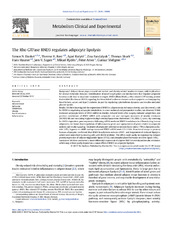| dc.contributor.author | Dankel, Simon N | en_US |
| dc.contributor.author | Røst, Therese Halvorsen | en_US |
| dc.contributor.author | Kulyté, Agné | en_US |
| dc.contributor.author | Fandalyuk, Zinayida | en_US |
| dc.contributor.author | Skurk, Thomas | en_US |
| dc.contributor.author | Hauner, Hans | en_US |
| dc.contributor.author | Sagen, Jørn V. | en_US |
| dc.contributor.author | Rydén, Mikael | en_US |
| dc.contributor.author | Arner, Peter | en_US |
| dc.contributor.author | Mellgren, Gunnar | en_US |
| dc.date.accessioned | 2020-04-17T13:13:59Z | |
| dc.date.available | 2020-04-17T13:13:59Z | |
| dc.date.issued | 2019 | |
| dc.Published | Dankel SND, Røst TH, Kulyté A, Fandalyuk Z, Skurk T, Hauner H, Sagen JV, Rydén M, Arner P, Mellgren G. The Rho GTPase RND3 regulates adipocyte lipolysis. Metabolism: Clinical and Experimental. 2019;101:153999 | eng |
| dc.identifier.issn | 1532-8600 | |
| dc.identifier.issn | 0026-0495 | |
| dc.identifier.uri | https://hdl.handle.net/1956/21927 | |
| dc.description.abstract | Background: Adipose tissue plays a crucial role in diet- and obesity-related insulin resistance, with implications for several metabolic diseases. Identification of novel target genes and mechanisms that regulate adipocyte function could lead to improved treatment strategies. RND3 (RhoE/Rho8), a Rho-related GTP-binding protein that inhibits Rho kinase (ROCK) signaling, has been linked to diverse diseases such as apoptotic cardiomyopathy, heart failure, cancer and type 2 diabetes, in part by regulating cytoskeleton dynamics and insulin-mediated glucose uptake. Results: We here investigated the expression of RND3 in adipose tissue in human obesity, and discovered a role for RND3 in regulating adipocyte metabolism. In cross-sectional and prospective studies, we observed 5-fold increased adipocyte levels of RND3 mRNA in obesity, reduced levels after surgery-induced weight loss, and positive correlations of RND3 mRNA with adipocyte size and surrogate measures of insulin resistance (HOMA2-IR and circulating triglyceride/high-density lipoprotein cholesterol (TAG/HDL-C) ratio). By screening for RND3-dependent gene expression following siRNA-mediated RND3 knockdown in differentiating human adipocytes, we found downregulation of inflammatory genes and upregulation of genes related to adipocyte ipolysis and insulin signaling. Treatment of adipocytes with tumor necrosis factor alpha (TNFα), lipopolysaccharide (LPS), hypoxia or cAMP analogs increased RND3 mRNA levels 1.5–2-fold. Functional assays in primary human adipocytes confirmed that RND3 knockdown reduces cAMP- and isoproterenol-induced lipolysis, which were mimicked by treating cells with ROCK inhibitor. This effect could partly be explained by reduced protein expression of adipose triglyceride lipase (ATGL) and phosphorylated hormone-sensitive lipase (HSL). Conclusion: We here uncovered a novel differential expression of adipose RND3 in obesity and insulin resistance, which may at least partly depend on a causal effect of RND3 on adipocyte lipolysis. | en_US |
| dc.language.iso | eng | eng |
| dc.publisher | Elsevier | eng |
| dc.rights | Attribution CC BY | eng |
| dc.rights.uri | http://creativecommons.org/licenses/by/4.0 | eng |
| dc.title | The Rho GTPase RND3 regulates adipocyte lipolysis | en_US |
| dc.type | Peer reviewed | |
| dc.type | Journal article | |
| dc.date.updated | 2020-01-28T10:07:12Z | |
| dc.description.version | publishedVersion | en_US |
| dc.rights.holder | Copyright 2019 The Author(s) | |
| dc.identifier.doi | https://doi.org/10.1016/j.metabol.2019.153999 | |
| dc.identifier.cristin | 1748275 | |
| dc.source.journal | Metabolism: Clinical and Experimental | |

